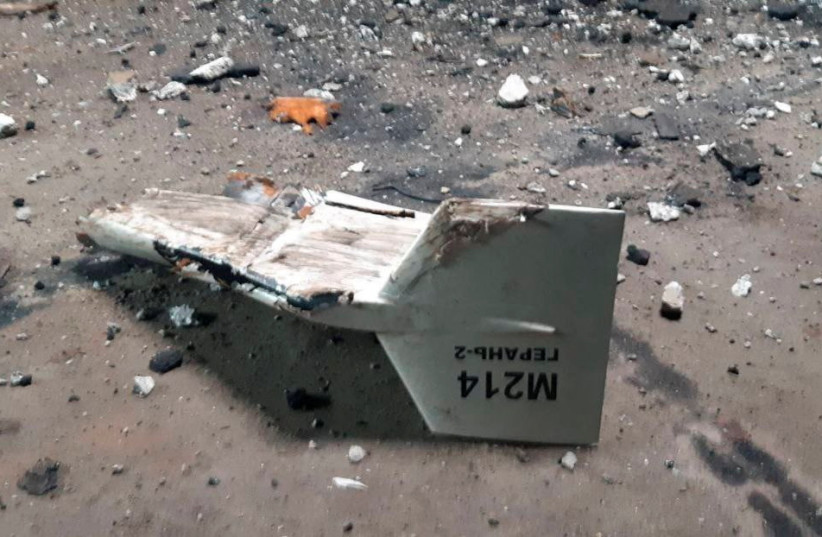Iran’s drone attack on Tuesday in the Gulf of Oman is its second in the last few months. Last July, it attacked the Mercer Street oil tanker, killing two crew members.
These attacks are so hard to prevent because the ships are simply vulnerable. They cannot easily be armed with air defenses and it’s unclear how they would be able to detect and escape strikes by kamikaze-style drones.
What we know about the November 15 attack is as follows.
US Central Command announced after the attack that an Iranian Shahed-series UAV struck the civilian commercial tanker, the Pacific Zircon. The vessel was damaged but no crew members were harmed.
The drone flew out of the IRGC’s regional command center in Chabahar in southeastern Iran.

These are the types of kamikaze drones that the Islamic Republic has perfected over the last few years. It may be similar to the Shahed-136 drones that it exported to Russia.
The US called the attack “destabilizing,” pointing out that it has a number of ships in the region, including patrol aircraft, and recently interdicted a shipment of 70 tons of missile fuel that was transported to Yemen to the Iran-backed Houthi group. “This type of shipment and just the massive volume of explosive material is a serious concern because it is destabilizing,” Commander Timothy Hawkins, a spokesperson for the Navy's Mideast-based 5th Fleet, told The Associated Press.
“The unlawful transport of weapons from Iran to Yemen leads to instability and violence,” he said.
“This type of shipment and just the massive volume of explosive material is a serious concern because it is destabilizing.”
Cmdr. Timothy Hawkins
The navies in the Gulf don’t have enough ships to defend the whole area from drone attacks. The overall sea area within the range of Iranian drones in this region could be some 1.7 million square kilometers, if Iran can also launch its Shaheds from Yemen itself. It doesn’t seem possible or plausible that so many square kilometers nor the tens of thousands of ships can be defended.
However, in the case of Iran, these two gulf attacks are the exception, not the rule. They were thought to be linked to Israeli owners, which is why Iran attacked; they were not military targets.
Iran and its proxies have also targeted other vessels. In May and June of 2020, a number of ships were struck off the coast of the UAE. Iran has also targeted US naval ships as well as UK- and Greek-owned ones. In June 2019 two ships, one operated by a Japanese company and the other by a Norwegian company, were targeted by mines.
This means that Iran’s long arm, including using fast boats and drones, can threaten the region. Even if one were to reduce the number of possible targets by selecting out the ships flagged and owned by countries unlikely to be threatened, there are still thousands of potential targets.
Air defense systems cannot be put on these ships – arming commercial ships in general is frowned upon internationally. In the 1980s, the US engaged in Operation Earnest Will to protect ships in the Persian Gulf, which involved the re-flagging of Kuwaiti ships. Iran and Iraq both attacked ships beginning in 1984.
The drone attacks today are not a new type of policy by Iran – and it’s not a unique policy that it invented. But drones pose a new type of threat and it’s unclear how Tehran has been able to program the drones to carry out these missions. A moving ship is difficult to strike with a drone that relies on coordinates or way points during its mission.
If it has to fly toward a moving ship, this means it needs a way for the drone to track it. It’s also not clear if Iran is able to guide the drone to strike a certain part of the ship.
If drones are striking tankers, they could cause an environmental catastrophe. They could also be used to disable a ship by striking at the rudder area. This is a deadly weapon – and many questions about its guidance and the munitions it carries still need to be answered.
This is why the drones are hard to deal with as a threat. It’s not always clear where the drones might be flown from, and after they are detected, it’s hard to shoot them down or jam them and push them off course.
Drones are usually slow, so if they are detected, they can be shot down by armed planes or even helicopters, but that would require the US or other countries to have planes on standby to intercept them.
Advanced warning might be more helpful.
